Introduction: Wireless Wonderland or Dropout Disaster?
Picture this: You’re mid-solo, absolutely melting faces, when suddenly—silence. Your wireless rig just ghosted you like a bad Tinder date. The audience is confused. You? You’re questioning your life choices.
If you’ve ever dealt with wireless guitar dropouts, interference, or lag, you’ve probably wondered, “What the hell is up with these frequency bands?” UHF, 2.4GHz, 5.8GHz—what’s the difference? More importantly, which one is actually the best for you?
Let’s break it all down, with no tech-jargon headaches, no BS, and a whole lot of useful info—so you can pick the right system and keep your signal solid as a rock.

1. The Science-y Stuff: What the Heck is a Frequency Band?
Before we start throwing numbers around like a game of frequency bingo, let’s get a super simple definition out of the way:
A frequency band is basically a designated chunk of the radio wave spectrum that devices use to transmit signals wirelessly. Your wireless guitar system, your Wi-Fi router, your Bluetooth headphones—all of them rely on different frequency bands to talk to their respective receivers.
Each band has its own pros, cons, and quirks—which is why choosing the right one for your wireless guitar system actually matters.
2. The Big Three: UHF vs. 2.4GHz vs. 5.8GHz
UHF (Ultra High Frequency: 470MHz–698MHz)
The old-school pro’s choice.
-
Pros:
✅ Longest range (great for big-ass venues)
✅ Strong signal penetration through walls, crowds, and other obstacles
✅ Less interference from Wi-Fi and Bluetooth -
Cons:
❌ Some UHF frequencies have been banned or repurposed (check your local laws!)
❌ Analog UHF can slightly color your tone compared to digital systems - Best for: Serious gigging musicians, large venues, and pros who need ultra-reliable performance.
🎸 CFG’s UHF System: Coming Soon! Stay tuned for our high-powered UHF unit—we’re cooking up something serious.
2.4GHz (Wi-Fi Frequency Band)
The digital workhorse.
-
Pros:
✅ Global, unlicensed use (works anywhere in the world)
✅ Digital signal = clear, high-fidelity tone
✅ Compact, easy to set up, and affordable -
Cons:
❌ Shares space with Wi-Fi, Bluetooth, and microwaves—so interference can be a thing
❌ Limited range in congested areas - Best for: Home players, small venue gigs, and anyone who wants a budget-friendly digital system.
🎸 CFG’s Pick: CF-80 Wireless System
If you need a solid, reliable 2.4GHz system, look no further. Crystal-clear tone, easy setup, and no cables tripping you up.
5.8GHz (The "New Kid" on the Block)
A less crowded alternative to 2.4GHz.
-
Pros:
✅ Less interference than 2.4GHz (fewer devices use 5.8GHz)
✅ Digital signal for high-quality audio
✅ Good balance between range and clarity -
Cons:
❌ Shorter range than UHF
❌ Some interference from newer tech (routers, drones, and other 5.8GHz devices) - Best for: Medium-sized gigs, players who want clear digital tone but don’t trust 2.4GHz.
🎸 CFG’s Pick: SonikSphere 5.8GHz Wireless System
If you want great digital sound without the Wi-Fi battles, 5.8GHz is the way to go.

3. The Real-World Experience: What Musicians Say
We didn’t just pull this info out of thin air—we ran a full-blown field test. We gathered a focus group of 50 musicians, handed them all three systems (including our upcoming UHF prototype), and let them put each one through its paces for 3–4 weeks. No theory—just real-world use.
After weeks of sweaty gigs, crowded rehearsal rooms, and questionable bar stages, we asked them to rate each system based on their experience. Here’s what we got:
🎤 UHF (Ultra High Frequency) – “Rock-solid reliability.”
Our testers unanimously agreed that UHF felt the most stable, even in large venues with tons of competing signals. They also loved the longer range and signal penetration, but some noted that it felt slightly less “hi-fi” compared to the digital options.
📡 2.4GHz (Wi-Fi Frequency Band) – “Convenient, but Wi-Fi is a gamble.”
Musicians loved the plug-and-play ease of 2.4GHz systems, with many praising the crisp, digital sound quality. However, those playing in venues with heavy Wi-Fi traffic reported occasional dropouts or interference, especially in city areas.
🚀 5.8GHz (Less Crowded, More Clarity) – “The happy medium.”
The biggest surprise of the test? 5.8GHz scored the highest for digital clarity and reliability in mid-sized venues. Testers found fewer dropouts than 2.4GHz and noticed little to no latency. The only real tradeoff? It doesn’t have the same range as UHF.
The Verdict?
Each system had its strengths, but here’s how our 50-player focus group summarized it:
- UHF = The tank – Built for touring pros who need bulletproof reliability.
- 2.4GHz = The easy rider – A solid, convenient pick for home studios and small gigs.
- 5.8GHz = The sweet spot – Clean, digital sound with less interference risk than 2.4GHz.
And there you have it—real musicians, real tests, real results.

4. Key Considerations When Choosing Your Wireless System
Still not sure which frequency band to roll with? Here’s a quick decision guide:
Do you play large venues or tour a lot?
✔️ Go UHF. It’s built for reliability and long-range performance.
Want simple, affordable, and easy-to-use?
✔️ Go 2.4GHz. It’s the most plug-and-play option and works worldwide.
Want digital sound but less Wi-Fi interference?
✔️ Go 5.8GHz. It’s a great balance of clarity and stability.
5. The Future of Wireless Guitar Systems
The wireless game is always evolving. Will UHF stay king? Will 5.8GHz take over? Some trends we’re keeping an eye on:
• UHF is still the pro standard, but available frequencies are shrinking.
• 2.4GHz is still super common, but interference issues might drive players toward 5.8GHz.
• Hybrid digital systems could be the next big thing—mixing UHF and digital transmission for the best of both worlds.
For now, your best bet is to pick a system that fits your gigs, your sound, and your budget—and hey, if you need help, we’ve got your back.
Final Breakdown: Which Wireless Frequency is Right for You?
| Frequency Band | Best For | Pros | Cons | CFG’s Pick |
|---|---|---|---|---|
| UHF | Pros, large venues, touring | Long range, rock-solid signal, less interference | Limited frequency availability, slight tone coloring | ⚡ Coming soon! |
| 2.4GHz | Home players, small gigs, budget-conscious musicians | Easy setup, affordable, high-fidelity sound | Wi-Fi interference, limited range in crowded areas | 🎸 CF-80 Wireless |
| 5.8GHz | Mid-sized venues, players wanting clean digital sound | Less interference than 2.4GHz, solid clarity | Shorter range than UHF, some interference from new tech | 🚀 SonikSphere 5.8GHz |
Final Thoughts: Go Wireless, Stay Free
No matter what frequency you choose, ditch the cables, keep your tone clean, and play with confidence. Just make sure to pick the right system for your needs—and maybe keep a backup cable handy, just in case. 😉
Got questions? Hit us up—we love talking gear almost as much as we love playing it. Now go forth and shred, cable-free!






